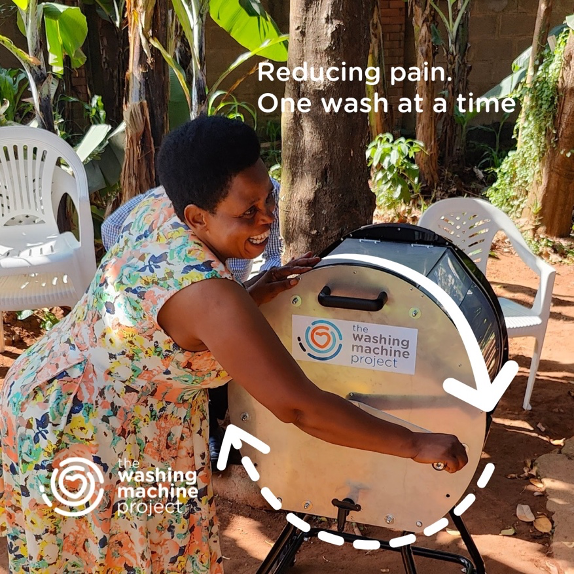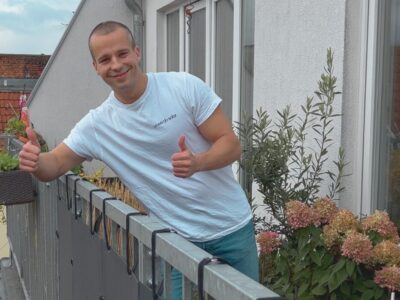In remote and low-income areas of the world, a lot of time and water is wasted hand-washing clothes. The United Nations Human Settlements Program estimates that only 2 billion people around the globe have access to washing machines, leaving more than 5 billion without such amenities.
Moreover, UNICEF and the World Health Organization report that the chore of hand washing laundry falls on women and girls in seven out of 10 households without water supplies on their land. Like many good stories, the story of a hand-cranked washing machine that is changing lives begins with family and friendship.

Photo Courtesy The Washing Machine Project
Engineering Roots
Navjot Sawhney — Nav for short, which means “new” in Punjabi — is the son of an engineer. “He’d encourage me to figure out how things worked,” Sawhney told The Mirror about his father, which led him to take apart home appliances and put them back together. “It would drive Mum nuts, but I was fascinated by the mechanics behind the gadgets.”
Sawhney would later follow in his father’s career footsteps by studying aerospace engineering at Queen Mary University of London. He was then accepted into a graduate program at Dyson’s, where he learned about designing products.
“I realized three years into my role that I was just making vacuum cleaners for rich people, and I was getting increasingly frustrated with the fact that my engineering was providing solutions for people who already have everything,” he reminisced to Design Week.

Photo Courtesy The Washing Machine Project
Lifechanging Experience
So, Sawhney left his job and joined Engineers Without Borders UK, an NGO focused on globally responsible engineering. He packed his things and set course for southern India, where he helped make cooking stoves for an organization called Prakti to help locals transition from using open fires.
Three important things happened while living in the village of Kallipalayam in Tamil Nadu. First, despite his extensive engineering background, Sawhney was inspired by a design process to which he had never been exposed. He refers to it as a “living lab” in conversation with Design Week.
“How it worked was on Monday we’d have an idea, on Tuesday we’d prototype that idea, on Wednesday we’d put the prototype into the field with potential users, get feedback on the Thursday, and have a new design by Friday,” he said.
The feedback was essential to the process. “The women using it would be able to feed back to us whether they liked it or not,” Sawhney told Oxfam. “Whether the chapati would puff enough, or if the pot was too small or too big, the handle too awkward; the sides too hot.”

Photo Courtesy The Washing Machine Project
Second, he became more familiar with the living circumstances of the people in that part of the world. He found a lack of reliable electricity led people to spend hours doing chores that would take only minutes for him back home. Third, he met Divya.
Divya lived next door to Sawhney during his time in India. She had learned English as a child, which enabled them to become fast friends, and he helped her son study with his phone’s flashlight when the power went out.
“She was spending up to 20 hours a week hand washing her family’s clothes, and as a result had chronic back pain and sore hands from the detergent,” he described to The Guardian. All the difficult housework also detracted from the time she wanted to devote to starting a business and contributing to her son’s education.
She reminded him of his mother, Mohini, who had to take care of three kids when Sawhney’s dad passed away from heart failure when he was just 8 years old. “As soon as she came home from her job in the civil service, there was cooking, cleaning, and laundry to do,” Sawhney said to the Mirror. “My siblings and I would try and help out around the house, but we were only young.”
New Calling Revealed
So, as he told Oxfam, he found a new calling through his new friendship: “I was like, ‘You know what? Maybe I can make you a washing machine, Divya. That would be a really interesting thing to do.’ Her eyes lit up, and she was like, ‘I’d love that.’”

Photo Courtesy The Washing Machine Project
After heading back to the United Kingdom, Sawhney gathered a group of friends with backgrounds in engineering, data science, and anthropology to develop a prototype. The result was a grassroots social enterprise, the Washing Machine Project, officially born in 2019. The goal: alleviate the burden of hand washing clothes, one wash at a time.
The development process was particularly interesting. While working on the first prototype, Sawhney started pursuing a master’s degree in humanitarianism, conflict, and development at the University of Bath.
Dr. Oliver Walton, director of studies for the degree, noted that the Washing Machine Project “has been able to draw on a number of other students on the course who are already skilled practitioners while also providing volunteering opportunities to students with less experience.” For example, one of Sawhney’s classmates was working in Iraq and asked him to test the prototype in the country’s refugee camps.
With an official invite from Care International in March 2019, Sawhney tested two prototypes with 79 families in four refugee camps in Kurdish Iraq in the north of the country. He found that most girls had begun hand washing clothes in their homes before they turned 16 — two before they were 8 years old. Seventy-eight percent of those surveyed said they had pain in their backs, hips, or knees.
Later, volunteers from the U.K. and seed funding from Oxfam and The Iraq Response Innovation Lab enabled the Washing Machine Project to build and deliver 50 devices there.

Photo Courtesy The Washing Machine Project
Iraq is just one of the five initial countries — India, Jordan, Lebanon, and the Philippines — where the Washing Machine Project surveyed an initial 500 people to get their feedback on the product. Indeed, that first trip to Iraq spawned several valuable insights.
“They wanted bigger drums, bigger capacity, easier maneuvering of the washing machine … They didn’t want to bend down,” Sawhney told Oxfam. “They didn’t want interaction with soap because it caused rashes. They wanted it to be light and portable. We incorporated all that into our design.”
Why all this effort? As he explained to the University of Bath, “The worst thing for us would be to produce something that no one uses, which is why we spend so much time with our beneficiaries.” Since then, these surveys have expanded to more than 3,000 families in 13 countries, including Cameroon, Jamaica, Kenya, Nepal, and Uganda.
Simple, Innovative Design
Inspired by a salad spinner, the product is the world’s first flat-packable manual washing machine and the only device of its kind made for humanitarian use. With an 11-pound drum capacity, it is designed for larger families in developing countries. Surveys revealed the average family size in Iraq was nine people, but Sawhney interviewed households with up to 13 people.
The machine uses only 2.6 gallons (10 liters) of water per wash cycle, contrasted with an average of 7.9 gallons (30 liters) in an electric washing machine; this is particularly beneficial in regions where water is hard to come by. Operated by a manual crank, the off-grid machine can be used without worrying about unreliable local electricity.

Photo Courtesy The Washing Machine Project
Moreover, the machine’s simplified design makes it easy to take apart. It is made of common, off-the-shelf parts that are easy to replace and affordable, with the machine costing just £24 ($31 U.S.).
“During my stay in India, I understood that up to a certain amount, women in rural areas had the liberty to spend; after that, they had to take permission from their husbands,” Sawhney detailed for The Logical Indian. “I wanted to price the washing machine in a range where women could buy the product without seeking permission from anyone.”
Plus, because it is composed of materials like stainless steel and wood, it is easier to recycle at the end of its life. Safety is also enhanced, with reduced contact between skin and detergents, leading to fewer instances of rashes, irritation, and dryness.

Photo Courtesy The Washing Machine Project
Impacting Families’ Daily Lives
All in all, the machine saves people 75% of time and 50% of water compared to traditional hand washing. One recipient in Uganda, named Kyifuko Ramla, has a son living with disabilities who cannot sit by himself or speak.
“Since hand washing requires much bending, and hand washing is time-consuming, that would imply giving my son less time, especially in regards to his feeding,” she explained. “So when I put clothes into the machine and wash them, it means I can multitask. I can leave the clothes in the machine and prepare a meal for my son or fix him something to drink and afterwards come back to the machine.”
This time can make all the difference, as Sawhney exclaimed to Oxfam. “We believe that using the washing machine, they could wash the same amount of clothes in 20 minutes,” he said. “So instead of 20 hours, 20 minutes. Can you imagine if you give back 20 hours to Divya, what she could do with her time? She could have the power to do whatever she wants.” It is, therefore, fitting that the product is called the Divya Washing Machine.
So far, the organization has distributed Divya Washing Machines to 30,000 people in India, Iraq, Lebanon, Mexico, Uganda, and the U.S. The organization pays close attention to cultural, economic, and environmental factors in each location to ensure the success of the solution there. Ultimately, “my hopes and dreams are to have a Washing Machine Project in every country in the world where it is needed,” according to Sawhney.

Photo Courtesy The Washing Machine Project
Awards and Collaborations
Although the global distribution network is still being set up, the Washing Machine Project has long been working with partner organizations, including Care International, Oxfam, Plan International, and Save The Children, to get its solution to the right places. Corporate supporters include Santander and JLR, where Sawhney worked as a senior cost engineer through 2022.
The University of Bath awarded the enterprise its Alumni Innovation Award in 2020, and the following year, Electrocomponents plc. and RS Group announced a fundraising commitment that would cover 7,500 washing machines to impact the lives of 100,000 people in 10 countries.
Most recently, the Whirlpool Foundation teamed up with the enterprise, with an estimated impact of 150,000 people in the next five years. The story came full circle this past March when Sawhney returned to India with the foundation, completing his promise to Divya.

Photo Courtesy The Washing Machine Project
Looking Toward The Future
The Divya Washing Machine is transforming lives. No doubt Sawhney’s father would have been proud, having been a refugee during the Partition of India, forced from his home with nothing except the clothes he was wearing. It is also altering gender roles.
“One of my favorite parts of my job is to talk to people in the field directly and hear men say to me ‘even I can wash clothes now’ as we are trying to equalize the gender imbalance we see across the world,” Sawhney said to Goodnet.
He told the Mirror, “My mother is really proud of me; she’s my biggest supporter. She is what drives me. I see her struggles in other women’s struggles.”

Photo Courtesy The Washing Machine Project
And who knows what is next? “Why should we stop at just washing machines?” he told The Guardian. “I remember when Divya and her family had to consume all of the food of the day because they didn’t have refrigeration. I just want to keep creating solutions that help people.” He has even hinted that the organization has a future product pipeline to address child protection, energy storage, food insecurity, and lighting over the next decade.





